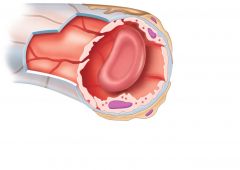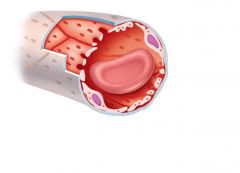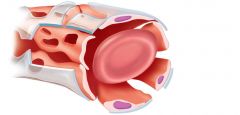![]()
![]()
![]()
Use LEFT and RIGHT arrow keys to navigate between flashcards;
Use UP and DOWN arrow keys to flip the card;
H to show hint;
A reads text to speech;
85 Cards in this Set
- Front
- Back
|
CHAPTER 19: CARDIOVASCULAR SYSTEM- BLOOD VESSELS
|
CHAPTER 19: CARDIOVASCULAR SYSTEM- BLOOD VESSELS
|
|
|
Define blood vessels
|
Delivery system of dynamic structures that begins and ends at the heart
|
|
|
3 Main Structures of Blood Vessels
|
Arteries- carry blood AWAY from the heart; oxygenated except for pulmonary circulation & umbilical vessels of a fetus
Capillaries- contact tissue cells and directly serve cellular needs Veins- carry blood TOWARD the heart. |
|
|
What 2 things are composed of 2 tunics?
|
Arteries and Veins
1. Tunica Interna (intima) 2. Tunica Media (**remember M for Muscle layer) 3. Tunica Externa (adventitia) |
|
|
What is central blood that contains space surrounded by tunics?
|
Lumen
|
|
|
What are capillaries composed of?
|
Endothelium with sparse basal lamina
|
|
|
Describe Tunica Interna (tunica intima)
|
Endothelial layer that lines the lumen of all vessels
|
|
|
Describe Tunica Media
|
-Smooth muscle and elastic fiber layer, regulated by symathetic nervous system
-Controls vasoconstriction/ vasodilation of vessels |
|
|
Describe Tunica Externa (tunica adventita)
|
-Collagen fibers that protect & reinforce vessels
-Larger vessels contain vasa vasorum "vessels of the vessels"- nourish the external tissues of the blood vessel wall. |
|
|
Describe Elastic (conducting) Arteries
|
-Thick walled arteries near the heart
-Aorta and its major branches -Large lumen allow low-resistance conduction of blood -Contain ELASTIN in all 3 tunics -Act as pressure reservoirs, expand and recoil as blood is rejected from the heart. **Pressure highest** |
|
|
Describe Muscular (distributing) Arteries
|
-Distal to elastic arteries
-Deliver blood to body organs -Have thick tunica media with more smooth vessel -Active in vasoconstriction |
|
|
What are arterioles?
|
-The smallest arteries
-lead to capillary beds -control flow into capillary beds via vasodilation & vasoconstriction. |
|
|
Capillaries: structure/function/describe
|
-Microscopic blood vessels
-Walls of thin tunica intima, 1 cell thick -Pericytes help stabilize their walls & control permeability -Size allows only single RBC's to pass at a time -In all tissues except for cartilage, epithelia, cornea and lens of eye -Functions: exchange of gases, nutrients, wastes, hormones, etc. |
|
|
Do arteries have valves?
|
No
|
|
|
What are 3 structural types of capillaries?
|
1. Continuous Capillaries
2. Fenestrated Capillaries 3. Sinusoidal Capillaries |
|
|
Describe Continuous Capillaries
|

-Abundant in the skin and muscles
-Continuous capillaries of the brain |
|
|
Describe Fenestrated Capillaries
|

Some endothelial cells contain pores (fenestrations)
More permeable than continuous capillaries Function in absorption or filtrate formation (small intestines, endocrine glands, and kidneys) |
|
|
Describe Sinusoidal Capillaries
|

Fewer tight junctions, larger intercellular clefts, large lumens
Usually fenestrated Allow large molecules and blood cells to pass between the blood and surrounding tissues Found in the liver, bone marrow, spleen |
|
|
How does the Blood Flow Through Capillary Beds
|
Through the Precapillary sphincter
-Cuff of smooth muscle that surrounds each true capillary -Regulates blood flow into the capillary |
|
|
When are venules formed and what do they allow?
|
-Venules are formed when capillary beds unite
-Allow fluids and WBCs to pass from the bloodstream to tissues |
|
|
What are the smallest venules and what are they composed of?
|
Postcapillary venules – smallest venules, composed of endothelium and a few pericytes
|
|
|
Large venules have how many layers of smooth muscle also known as?
|
Large venules have one or two layers of smooth muscle (tunica media)
|
|
|
___a___ have much lower blood pressure and thinner walls than ___b___
|
a. veins
b. arteries |
|
|
To return blood to the heart, veins have special adaptations, what are they?
|
-Large-diameter lumens, which offer little resistance to flow
-Valves (resembling semilunar heart valves), which prevent backflow of blood |
|
|
What are Venous sinuses ?
|
specialized, flattened veins with extremely thin walls (e.g., coronary sinus of the heart and dural sinuses of the brain)
|
|
|
What are Vascular Anastomoses? Where are they more common?
|
-Merging blood vessels
-More common in veins than arteries |
|
|
What do Arterial anastomoses provide ?
|
-Arterial anastomoses provide alternate pathways (collateral channels) for blood to reach a given body region
*If one branch is blocked, the collateral channel can supply the area with adequate blood supply |
|
|
Actual volume of blood flowing through a vessel, an organ, or the entire circulation in a given period:
|
-Is measured in ml per min.
-Is equivalent to cardiac output (CO), considering the entire vascular system -Is relatively constant when at rest -Varies widely through individual organs |
|
|
What is Blood Pressure? How is it expressed? What is it measured in reference to?
|
-Force per unit area exerted on the wall of a blood vessel by its contained blood
-Expressed in millimeters of mercury (mm Hg) -Measured in reference to systemic arterial BP in large arteries near the heart |
|
|
Opposition to flow is aka:
|
Resistance
|
|
|
Resistance measures the amount of
|
friction blood encounters
|
|
|
Resistance is referred to as:
|
peripheral resistance (PR)
|
|
|
The three important sources of resistance are:
|
1) Blood viscosity
2) Total blood vessel length 3) Blood vessel diameter |
|
|
Factors that remain relatively constant during resistance:
|
1. Blood viscosity-
The “stickiness” of the blood due to formed elements and plasma proteins 2. Blood vessel length- The longer the vessel, the greater the resistance encountered |
|
|
What are the major determinants of peripheral resistance?
|
Small-diameter arterioles are the major determinants of peripheral resistance
|
|
|
Abrupt changes in diameter or fatty plaques from _______a_____ dramatically increase resistance
|
a. atherosclerosis
**Disrupt blood flow and cause turbulence |
|
|
Relationship Between Blood Flow, Blood Pressure, and Resistance:
Blood flow (F) is directly proportional to the blood (hydrostatic) pressure gradient (P) |
If P increases, blood flow speeds up
|
|
|
Relationship Between Blood Flow, Blood Pressure, and Resistance:
Blood flow is inversely proportional to peripheral resistance (R) |
If R increases, blood flow decreases
|
|
|
What is more important in influencing local blood flow because it is easily changed by altering blood vessel diameter?
|
Resistance
|
|
|
What is Systemic Blood Pressure? What generates blood flow?
|
-The pumping action of the heart generates blood flow
-The pumping action of the heart generates blood flow |
|
|
Systemic pressure is highest in the? Declines throughout the? Is 0 mm Hg in which atrium?
|
-Is highest in the aorta
-Declines throughout the pathway -Is 0 mm Hg in the right atrium |
|
|
Arterial BP reflects two factors of the arteries close to the heart, what are they?
|
1. Their elasticity (compliance or distensibility)
2. The amount of blood forced into them at any given time |
|
|
What are 3 kinds of Arterial Blood Pressure?
|
1. Systolic Pressure
2. Diastolic Pressure 3. Mean arterial pressure (MAP) |
|
|
Define Systolic pressure:
|
Systolic pressure – pressure exerted on arterial walls during ventricular contraction
|
|
|
Define Diastolic pressure
|
Diastolic pressure – lowest level of arterial pressure
|
|
|
Define Mean arterial pressure (MAP)
|
Mean arterial pressure (MAP): pressure that propels the blood to the tissues (average blood pressure in an individual)
|
|
|
What are the Factors Aiding Venous Return:
|
1. Respiratory “pump”: pressure changes created during breathing move blood toward the heart by squeezing abdominal veins as thoracic veins expand
2. Muscular “pump”: contraction of skeletal muscles “milk” blood toward the heart and valves prevent backflow 3. Vasoconstriction of veins under sympathetic control |
|
|
The main factors influencing blood pressure are:
|
1. Cardiac output (CO)
2. Peripheral resistance (PR) 3. Blood volume |
|
|
Equation of Blood Pressure
|
Blood pressure = CO x PR
|
|
|
Cardiac Output (CO)
When resting.. When Under Pressure.. |
1. Resting heart rate is controlled by the cardioinhibitory center via the vagus nerves
2. Under stress, the cardioacceleratory center increases heart rate and stroke volume |
|
|
Control of blood pressure:
-Short-term neural and hormonal controls |
Counteract fluctuations in blood pressure by altering peripheral resistance
|
|
|
Control of blood pressure:
-Long-term renal regulation |
Counteracts fluctuations in blood pressure by altering blood volume
|
|
|
What is the Cardiovascular center
|
vasomotor center plus the cardiac centers that integrate blood pressure control by altering cardiac output and blood vessel diameter
|
|
|
What does the Vasomotor center oversee?
|
changes in blood vessel diameter
|
|
|
Short-Term Mechanisms: Vasomotor Activity
Increased sympathetic activity causes? |
Vasoconstriction and a rise in BP
|
|
|
Short-Term Mechanisms: Vasomotor Activity
Decreased sympathetic activity causes? |
BP to decline
|
|
|
Short-Term Mechanisms: Chemical Controls
Blood pressure is regulated by ______a._____ reflexes sensitive to ____b____ and carbon dioxide. _____c____chemoreceptors are the ____d___ and ___e____ bodies |
a. chemoreceptor
b. oxygen c. Prominent d. carotid e. aortic |
|
|
What are the Chemicals that Increase Blood Pressure?
|
1. Adrenal medulla hormones – norepinephrine and epinephrine increase blood pressure – cause vasoconstriction and increase cardiac output
2. Antidiuretic hormone (ADH) (Vasopressin) – causes intense vasoconstriction in cases of extremely low BP 3. Angiotensin II – kidney release of renin generates angiotensin II, which causes vasoconstriction |
|
|
What are the Chemicals that decrease Blood Pressure?
|
1. Atrial natriuretic peptide (ANP) – causes blood volume and pressure to decline (produced by atria of the heart)
2. Nitric oxide (NO) – is a brief but potent vasodilator 3. Inflammatory chemicals – ex) histamine ( a vasodilator) 4. Alcohol – causes BP to drop by inhibiting ADH |
|
|
How does Long-term mechanisms control BP ?
|
By Altering Blood Volume
|
|
|
What acts directly and indirectly to maintain long-term blood pressure?
|
The Kidneys
|
|
|
How does the Kidneys directly and indirectly maintain long term BP?
|
1. Direct renal mechanisms alters blood volume.
2.Indirect renal mechanism involves the reningiotensin mechanism. |
|
|
Direct Renal Mechanism
-Increased BP causes the Kidneys to.. -Decreased BP causes the Kidneys to.. |
-Increased BP or Blood Volume causes the kidneys to eliminate more urine, thus reducing BP.
-Decreasing BP or Blood Volume causes the kidneys to conserve water, and BP rises. |
|
|
Define Vital Signs
|
pulse and blood pressure, along with respiratory rate and body temperature
|
|
|
Define Pulse
|
pressure wave caused by the expansion and recoil of elastic arteries
-Radial pulse (taken on the radial artery at the wrist) is routinely used -Varies with health, body position, and activity |
|
|
Efficiency of the circulation can be assessed by
|
taking pulse and blood pressure measurements
|
|
|
______a______ is measured indirectly with the auscultatory method
|
a. Systemic arterial BP
|
|
|
What is the the auscultatory method?
|
1. A sphygmomanometer is placed on the arm superior to the elbow
2. Pressure is increased in the cuff until it is greater than systolic pressure in the brachial artery 3. Pressure is released slowly and the examiner listens with a stethoscope |
|
|
Measuring Blood Pressure:
1. The first sound heard is recorded as _______a______. 2. The pressure when sound disappears is recorded as the ________b_________. |
a. the systolic pressure (systolic pressure, normally 110–140 mm Hg)
b. diastolic pressure (diastolic pressure, normally 70–80 mm Hg) |
|
|
Describe some Variations in Blood Pressure
|
1. Blood pressure cycles over a 24-hour period
2. BP peaks in the morning due to levels of hormones 3. Extrinsic factors such as age, sex, weight, race, mood, posture, socioeconomic status, and physical activity may also cause BP to vary |
|
|
Term for Low Blood Pressure
|
Hypotension, which is an alteration in BP.
|
|
|
Hypotension is often associated with
|
long life and lack of cardiovascular illness
|
|
|
When Hypotension occurs, what is the Systolic Pressure?
|
Below 100 mm Hg
|
|
|
Define Orthostatic hypotension
|
*Homeostatic Imbalance
-temporary low BP and dizziness when suddenly rising from a sitting or reclining position |
|
|
Define Chronic hypotension
|
*Homeostatic Imbalance
-hint of poor nutrition and warning sign for Addison’s disease (adrenal isnsufficiency) or hypothyroidism |
|
|
Acute hypotension is an important sign of:
|
*Homeostatic Imbalance
circulatory shock |
|
|
Term for High Blood Pressure
|
Hypertension, which is an alteration in BP.
|
|
|
When Hypertension occurs, Sustained elevated arterial pressure is..
|
-140/90 or higher
|
|
|
Hypertension is common in...
|
Obese People
|
|
|
Prolonged hypertension is a major cause of:
|
heart failure, vascular disease, renal failure, and stroke
|
|
|
Primary or essential hypertension is what % of hypertensive conditions? What is it due to?
|
1. 90%
2. to several risk factors including heredity, diet, obesity, age, stress, diabetes mellitus, and smoking |
|
|
Secondary Hypertension is more or less common then primary hypertension? What is it due to?
|
1. Less
2. identifiable disorders, including kidney disease, arteriosclerosis, and endocrine disorders such as hyperthyroidism and Cushing’s syndrome (hyperadrenalism) |
|
|
Define Autoregulation
|
automatic adjustment of blood flow to each tissue in proportion to its requirements at any given point in time
|
|
|
When does angiogenesis occur? When is it common in the heart?
|
1. Occurs when short-term autoregulation cannot meet tissue nutrient requirements
1.The # of vessels to a region increases. 2. existing vessels enlarge 2. Common in heart when a coronary vessel is occluded and throughout the body in people in high altitude areas. |
|
|
When does muscle blood flow increase?
|
It increases tenfold or more during physical activity as vasodilation occurs
|

